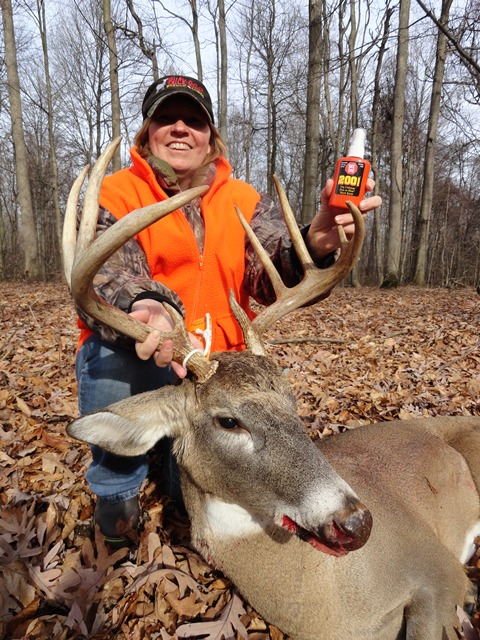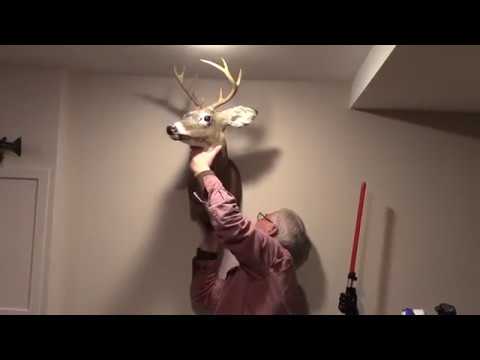Can Deer Smell You in a Tree Stand
Deer possess a keen sense of smell and can detect human scent from a tree stand. Elevating your position does not guarantee an odor-free presence.
Hunters often use tree stands to gain an aerial advantage, but success in the field requires managing your scent. Deer have an incredibly sensitive olfactory system, capable of picking up faint odors from significant distances. The elevated position of a tree stand can help reduce your scent’s strength at ground level, but it doesn’t make you invisible to a deer’s nose.
Wind direction, weather conditions, and your own scent control measures play crucial roles in minimizing your scent signature. By carefully considering these factors, a hunter can increase their chances of remaining undetected while waiting for the perfect shot. Being mindful of your scent and employing smart strategies can make all the difference during your hunt.
Understanding Deer’s Sense Of Smell
When it comes to the wild, few senses are as finely tuned as the olfactory abilities of deer. These majestic animals have evolved to become incredibly adept at detecting scents, making their sense of smell a pivotal asset for their survival. Hunters often wonder if deer can smell them even when perched high in a tree stand. The answer lies in understanding the remarkable capabilities of a deer’s nose. We’ll delve into the intricacies of how deer use their sense of smell to navigate the forest, avoid predators, and locate food.
How do deer use their sense of smell for survival?How Do Deer Use Their Sense Of Smell For Survival?
Deer rely heavily on their sense of smell to make critical decisions in the wild. This powerful sense is a key survival tool in the following ways:
- Detecting Predators: Deer can catch the scent of predators from a considerable distance, giving them time to evade danger.
- Locating Food: A refined sense of smell helps deer find nutrient-rich food sources, crucial especially during scarce periods.
- Communicating: Scent marking allows for territorial claims and helps deer communicate with each other.
- Mating: During the rut, bucks and does use scent to signal readiness and locate potential mates.
The Biological Mechanism Behind A Deer’s Sense Of Smell
The biology of a deer’s olfactory system is a marvel of nature, comprising several elements that contribute to their acute sense of smell. Let’s break down the key components:
| Component | Function |
|---|---|
| Nasal Cavity | The large surface area lined with olfactory receptors captures airborne molecules. |
| Olfactory Bulb | Located in the brain, it processes scent signals sent from the nasal receptors. |
| Vomeronasal Organ | Specialized for detecting pheromones, it plays a critical role during mating season. |
| Olfactory Epithelium | Home to millions of olfactory neurons, it detects odors and pheromones in the air. |
The remarkable sensitivity of a deer’s sense of smell is due to this sophisticated biological architecture, allowing them to detect odors we humans cannot even begin to perceive. A deer’s ability to smell a human in a tree stand is influenced by wind direction, weather conditions, and the hunter’s scent control measures. Understanding these biological principles can significantly improve a hunter’s approach to remaining undetected.
Factors Affecting Human Scent Detection By Deer
Deer possess an incredibly keen sense of smell, which they rely upon for survival. This heightened olfactory ability allows them to detect predators, including humans, from great distances. When hunters take to the trees, they often wonder, “Can deer smell you in a tree stand?” While gaining elevation can offer an advantage, various factors influence a hunter’s scent profile and its detection by deer. From wind direction to the choice of clothing and gear, hunters must strategize meticulously to minimize their scent signature.
Impact Of Wind Direction On Scent Dispersal
Understanding wind patterns is crucial for hunters aiming to conceal their presence from deer. Wind direction dictates how human scent travels through the environment. Hunters should always be aware of the wind’s direction in relation to their tree stand and target area. With the wind blowing from the deer towards the hunter, the risk of scent detection decreases significantly. Conversely, a wind blowing directly from the hunter to the deer can carry human scent straight to these vigilant creatures.
- Seek high ground: Positioning a stand on higher elevations might help disperse scent above deer.
- Use wind patterns: Planning hunts according to prevailing wind directions increases chances of remaining undetected.
- Monitor weather: Sudden changes in weather can shift wind patterns unexpectedly, potentially exposing the hunter.
How Clothing And Gear Affect Human Scent
The materials and maintenance of clothing and gear play a pivotal role in how much human scent is released into the environment. High-tech scent-blocking attire is designed to contain and minimize human odors. Utilizing scent-free soaps for body and laundry, and scent-eliminating sprays on gear, can further reduce the likelihood of detection. Hunters should also consider:
| Method | Effect on Scent Control |
|---|---|
| Activated Carbon Clothing | Adsorbs odor molecules, reducing human scent. |
| Scent-free Storage | Prevents clothing from absorbing external scents pre-hunt. |
| Ozone Generators | Chemically alters odor molecules to neutralize scents. |
Beyond external aids, personal hygiene also governs scent management. Adequate preparation involves showering with scent-free products and avoiding strong-smelling foods or fragrances before a hunt. Regular laundering of clothing and cleaning of gear are essential practices to maintain a low scent profile.
In essence, while height provides an advantage in a tree stand, meticulous attention to detail in scent management practices is the deciding factor in staying undetected. With proper planning and execution, the chances of a successful hunt increase dramatically.
Best Practices For Concealing Your Scent In A Tree Stand
Best Practices for Concealing Your Scent in a Tree Stand
As a hunter perched in a tree stand, the blend of stealth and scent management can be the difference between a successful hunt and a disappointing trip. Deer possess an incredibly acute sense of smell, allowing them to detect human scents from afar. Thwarting their sensory advantage is paramount. Efficient scent control practices range from pre-hunt rituals to utilizing specialized products that mask human odors. Embrace these strategies to enhance the likelihood of remaining undetected by vigilant deer.
Tips For Scent Control Before Heading To A Tree Stand
Scent control starts long before stepping foot in the wilderness. A meticulous approach to odor management can elevate the chances of a fruitful hunt. Careful preparation involves habits that are both thorough and purposeful:
- Shower with scent-free soap before heading out to eliminate odors from the body.
- Launder clothes in scent-free detergent and store them in an airtight container or scent-locking bag.
- Avoid contaminating gear and apparel with strong-smelling substances such as gasoline, smoke, or food.
- Apply scent-free deodorant and avoid the use of any products that could introduce foreign odors.
- Consider activating scent-covered wafers that replicate natural smells of the woods and mask human scents.
Following these steps vigilantly reduces the risk of detection, providing a critical edge in the quiet game of patience between hunter and prey.
The Effectiveness Of Scent-masking Products
Employing scent-masking products is a scientifically-backed strategy many hunters rely on to suppress human odor. The variety of options available can serve every stage of your hunting routine:
| Product Type | Function | Usage |
|---|---|---|
| Scent-Free Sprays | Neutralize odors on hunting gear | Apply liberally on gear before and during the hunt |
| Scent Control Clothing | Trap and contain body odors | Wear throughout the hunting excursion |
| Odor-Blocking Lotions | Prevent the emission of bodily scents | Apply to skin before dressing |
| Earth Scented Wafers | Mimic the natural odors of the environment | Attach to clothing or hang in tree stand area |
These products are designed to promote an olfactory camouflage, melding your presence into the natural background. Proper deployment heightens the prospect of a deer wandering within range, oblivious to the hunter above.
Keep in mind that no product is a silver bullet; the best results stem from a combination of methods deployed in concert. Meticulous execution of these scent control techniques can significantly tip the balance in your favor during your next hunt.
Strategic Placement Of Tree Stands To Minimize Scent Detection
As a hunter seeking the advantage in the wild, understanding the keen senses of your game is crucial. Deer, with their exceptional sense of smell, are particularly challenging. The strategic placement of tree stands plays a pivotal role in minimizing scent detection, allowing hunters to remain virtually invisible high above their quarry. It’s a delicate dance between skill, understanding the environment, and applying proven tactics to outwit these perceptive creatures.
Ideal Locations And Wind Conditions For Setting Up Tree Stands
Selecting the perfect location for a tree stand involves more than just finding a spot with a clear view. It’s about merging with the environment and considering how the wind can betray your presence. Here are key considerations:
- Elevation: Higher elevations can help disperse your scent above the deer’s detection zone.
- Prevailing Winds: Understanding the typical wind patterns of your hunting area is critical. Set up your tree stand downwind of known deer paths.
- Sunrise/Sunset: Consider the wind changes that occur as temperatures rise and fall during these times, as they can affect scent travel.
Enhancing Natural Cover And Scent Control In The Vicinity
To further minimize your scent signature while in a tree stand, incorporating natural cover and practicing stringent scent control is necessary:
Natural Cover:
- Vegetation: Use surrounding foliage to mask your presence both visually and olfactorily.
- Background: Position your stand against a backdrop that breaks up your silhouette, such as a thick tree trunk or dense canopy.
Scent Control:
- Scent-Eliminating Products: Invest in soaps, sprays, and laundry detergents designed to neutralize human odors.
- Keep Gear Clean: Regularly wash your clothing and gear, including the tree stand, to eliminate residual smells.
Leveraging Decoy Scent Techniques In Tree Stands
Bowhunters and wildlife enthusiasts understand the challenge of remaining undetected while in their tree stands. Deer possess a keen sense of smell, often making it difficult to observe or hunt them without alerting these vigilant creatures. Fortunately, savvy outdoorsmen can outwit a deer’s nose by utilizing decoy scent techniques. By smartly introducing attractants and lures into the environment, you can effectively mask human odor and enhance your presence in the wild. Let’s explore how you can employ these tactics to tip the scales in your favor.
Using Deer Attractants To Divert Attention From Human Scent
Deer attractants serve as a powerful tool to divert a deer’s attention away from the distinctive scent of a human in a tree stand. These lures—ranging from doe-in-estrus scents to food-based aromas—can captivate a deer’s curiosity and encourage them to venture closer without alarm. When strategically placed, these scents can create a scent trail leading away from the stand, thus minimizing the risk of detection.
- Buck urine: A go-to during the rut season, mimicking the presence of a rival male.
- Doe estrus: Highly effective during the breeding season, signaling the availability of a mate.
- Acorn scent: Perfect for creating a false food source, which can be irresistible to foraging deer.
It’s essential to apply these attractants with caution to avoid over-saturation, which can alert deer to unnatural concentrations of scents. Choose products wisely and apply them in moderation for the best results.
Techniques For Effectively Deploying Scent Lures From A Tree Stand
Effective deployment of scent lures from a tree stand requires a tactical approach. Positioning and timing are critical in persuading a deer to investigate the scent without becoming suspicious of human presence.
- Wind Direction: Always consider the wind direction before applying scent. You’ll want to disperse the scent downwind, so it drifts naturally through the area where deer are likely to approach.
- Distance: Place scent lures at varying distances from your stand to create a natural scent pattern that deer can follow, leading them to an ideal viewing or shooting lane.
- Scent Dispensers: Use drip bags, wicks, or spray bottles to control the distribution of scent. This ensures a slow and continuous release that mimics real-world conditions.
By implementing these techniques, you can set up a convincing scent profile that entices deer and keeps their focus away from your position in the tree stand. When done correctly, the use of scent lures can significantly increase your chances of a successful encounter with these majestic animals.

Credit: buckstopscents.com
Frequently Asked Questions Of Can Deer Smell You In A Tree Stand
Can Deer Detect Human Scent From Above?
Deer have a keen sense of smell and can detect human scent regardless of height. While a tree stand elevates you, reducing your scent’s reach on the ground, it’s not foolproof. Wind can carry your scent to the deer, alerting them to your presence.
Do Weather Conditions Affect Scent Detection In A Tree Stand?
Yes, weather conditions play a crucial role in scent detection. Rain can help mask your scent, while dry conditions can make it linger longer. Wind direction is also key, as it can blow your scent towards or away from deer.
Always be mindful of the wind when in a tree stand.
How Can I Reduce My Scent While Hunting In A Tree Stand?
Minimize your scent by using scent-eliminating sprays and washing your hunting clothes with scent-free detergents. Also, avoid strong-smelling foods and scented products before a hunt. Climbing higher can also help, as your scent disperses more with elevation.
What’s The Best Height For A Tree Stand To Avoid Deer’s Smell?
There is no guaranteed safe height; deer can smell you at any elevation. However, most hunters agree that stands at 20-30 feet high can reduce the chances of scent detection. Higher stands disperse your scent above the deer’s immediate scent cone more effectively.
Conclusion
Deer possess a keen sense of smell, making stealth crucial for hunters in tree stands. By minimizing scent and employing strategic techniques, your chances of remaining undetected improve significantly. Remember, success in the wild is often a game of senses—stay vigilant and respectful of the woodland creatures’ capabilities.
Embrace the challenge and enjoy the hunt!




